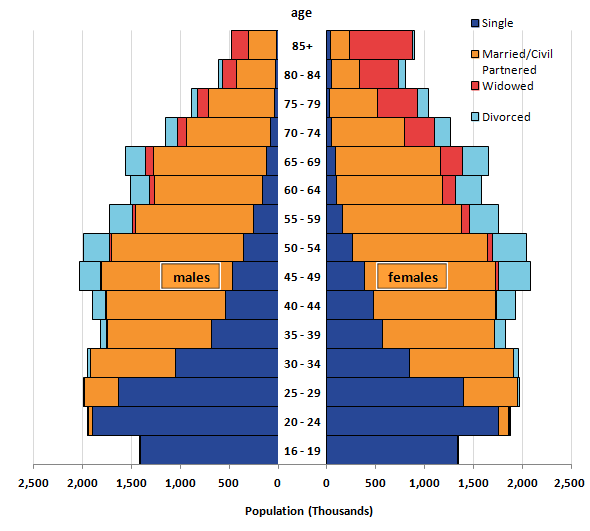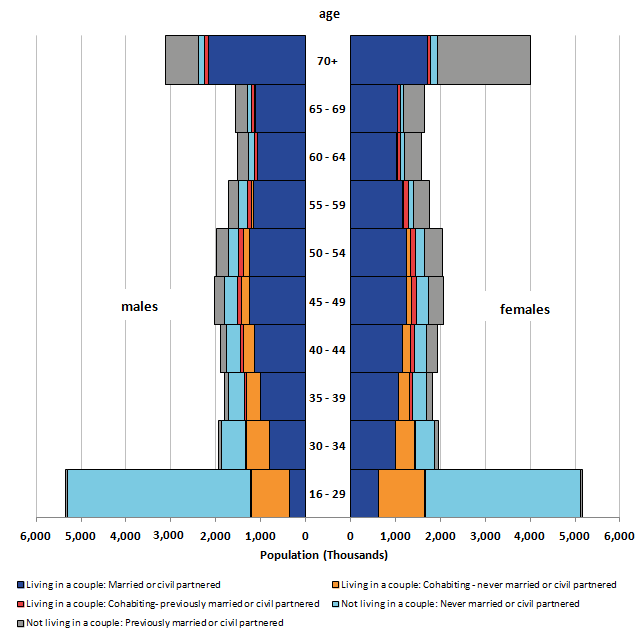Cynnwys
- Main points
- Statistician’s quote
- Things you need to know
- Married people are the largest group in the population aged 16 and over
- Living in a couple is the most popular living arrangement for those aged 16 and over
- The percentage of the population who are married has declined while the percentage who are single has increased
- The population who are single, never married or civil partnered are increasingly cohabiting
- Links to ONS-related statistics
- What has changed within this publication?
- Quality and Methodology
1. Main points
There were 23.8 million people who were married in 2015. This was 50.6% of the population aged 16 and over.
The population aged 16 and over who were single increased from 29.6% in 2002 to 34.5% in 2015.
There were 28.4 million people living in a couple in 2015. This was 60.5% of the population aged 16 and over.
The population aged 16 and over who were “cohabiting, never married or civil partnered” increased from 6.8% in 2002 to 9.5% in 2015.
Nôl i'r tabl cynnwys2. Statistician’s quote
Pamela Cobb, Population Statistics Division, Office for National Statistics.
Nôl i'r tabl cynnwys3. Things you need to know
Marital status indicates whether a person is legally married or not. This publication uses 5 categories of legal marital status:
- single, never married or civil partnered
- married, including separated (this category includes those in both opposite and same sex marriages)
- civil partnered, including separated
- divorced, including legally dissolved civil partners
- widowed, including surviving civil partners
Living arrangements indicate whether people are living with a partner or not, irrespective of their legal marital status.
Those aged under 16 are all considered to be single in line with the legal age of marriage in England and Wales. This bulletin focuses on the population aged 16 and over.
This publication does not include estimates of couples who are living apart together (LAT).The Quality and Methodology Information document provides further detail.
Nôl i'r tabl cynnwys4. Married people are the largest group in the population aged 16 and over
The majority (50.6%) of the population aged 16 and over in 2015 were married. The next largest group within the population were single, never married or civil partnered (34.5%). The population who were divorced or widowed made up a smaller proportion of the total population at 8.1% and 6.5% respectively. The smallest group within the population were those who were civil partnered, making up 0.2% of the population aged 16 and over in 2015.
Table 1: Marital status (aged 16 and over), 2015
| England and Wales | |||||
| Single1 | Married | Civil partnered | Divorced | Widowed | |
| Total number | 16,197,748 | 23,750,695 | 96,180 | 3,817,912 | 3,062,475 |
| Percentage of population aged 16 and over | 34.5% | 50.6% | 0.2% | 8.1% | 6.5% |
| Source: Office for National Statistics | |||||
| Notes: | |||||
| 1. See the 'Things you need to know' section for details about each marital status category. | |||||
Download this table Table 1: Marital status (aged 16 and over), 2015
.xls (26.1 kB)In 2015, the number of people aged 16 and over in a same sex marriage was 26,023 – 0.1% of the married population – in England and Wales. Males accounted for 51% (13,150) of the population in a same sex marriage and females the remaining 49% (12,872).
Figure 1: Population Estimates (aged 16 and over) by marital status, age group and sex, 2015
England and Wales

Source: Office for National Statistics
Notes:
- See the 'Things you need to know' section for details about each marital status category.
- Married and civil partnered are combined in this chart due to the small numbers of civil partners.
Download this image Figure 1: Population Estimates (aged 16 and over) by marital status, age group and sex, 2015
.png (22.9 kB) .xls (28.7 kB)The female population who are divorced was larger than the male divorced population in 2015. This could be associated with the remarriage rates (number marrying per 1,000 widowed or divorced population) seen for males and females (Marriages in England and Wales: 2013). In 2013 the remarriage rate for men was 25.3 per 1,000 and for women 12.2 per 1,000 suggesting more men tend to re-marry compared with women. Women may choose to remain partnerless or cohabit rather than remarry.
In 2015, the difference in the number of widowed males and females, especially at older ages, could be explained by women having higher life expectancy than men, and women traditionally marrying an older spouse (National Life Tables, United Kingdom: 2012-2014).
In 2015, 51.7% of men and 49.6% of women aged 16 and over were married. Being married was the most common marital status for women aged between 30 to 34 and 80 to 84 in 2015. For men, being married was the most common marital status after age 30 to 34. A marital status of single, never married was most common for those aged under 30.
Nôl i'r tabl cynnwys5. Living in a couple is the most popular living arrangement for those aged 16 and over
The majority (60.5%) of the population aged over 16 were living in a couple in 2015. Those who were living in a couple were most likely to be married or civil partnered.
The remainder of the population aged 16 and over in 2015 were not living in a couple (39.5%). Those who were not living in a couple were most likely to be single, never married or civil partnered.
Table 2: Living arrangements (aged 16 and over), 2015
| England and Wales | |||||
| Living in a couple | Not living in a couple | ||||
| Married or civil partnered | Cohabiting - never married or civil partnered | Cohabiting- previously married or civil partnered | Never married or civil partnered | Previously married or civil partnered1 | |
| Total number | 22,585,950 | 4,472,288 | 1,314,889 | 11,718,395 | 6,833,488 |
| Percentage of population aged 16 and over | 48.1% | 9.5% | 2.8% | 25.0% | 14.6% |
| Source: Office for National Statistics | |||||
| Notes: | |||||
| 1. People who are married or civil partnered but whose partner is away from the household because they live away for work, are in prison or in a care home, will appear in this category. | |||||
Download this table Table 2: Living arrangements (aged 16 and over), 2015
.xls (27.6 kB)
Figure 2: Population estimates (aged 16 and over) by living arrangements, age group and sex, 2015
England and Wales

Source: Office for National Statistics
Notes:
- People who are married or civil partnered but whose partner is away from the household because they live away for work, are in prison or in a care home, will appear in the ‘not living in a couple: previously married or civil partnered’ category.
Download this image Figure 2: Population estimates (aged 16 and over) by living arrangements, age group and sex, 2015
.png (28.9 kB) .xls (28.2 kB)At ages 16 to 29 the majority of males and females were ‘Not living in a couple: Never married or civil partnered’, 76.5% and 66.6% respectively. They were likely to be living with their parents but could have been in relationships outside of the household (Families and Households: 2015). In 2015 there was a difference between males (15.9%) and females (20.1%) aged 16 to 29 who were “living in a couple: cohabiting – never married or civil partnered”. This could be associated with women choosing to live with partners older than themselves.
In 2015 the biggest difference between males and females can be seen in the “not living in a couple” category where a larger percentage of women, especially at the oldest ages, were “not living in a couple: previously married or civil partnered”. This is likely to be due to the larger number of women who were divorced or widowed compared with men.
Nôl i'r tabl cynnwys6. The percentage of the population who are married has declined while the percentage who are single has increased
Figure 3: Percentages of people (aged 16 and over) by selected marital status, 2002 to 2015
England and Wales
Source: Office for National Statistics
Notes:
- Data in figures 3 and 4 have been plotted separately so that trends in the data can be clearly seen.
Download this chart Figure 3: Percentages of people (aged 16 and over) by selected marital status, 2002 to 2015
Image .csv .xlsThe percentage of people aged 16 and over who are married has decreased over time from 54.8% in 2002 to 50.6% in 2015. The percentage of people aged 16 and over who are single has increased over time from 29.6% in 2002 to 34.5% in 2015. This coincides with an increase in people cohabiting who are never married or civil partnered (Figure 5), as cohabitation has become more common as an alternative to marriage, especially at younger ages. The rise in single population also reflects more people in middle age groups remaining unmarried.
Figure 4: Percentages of people (aged 16 and over) by selected marital status, 2002 to 2015
England and Wales
Source: Office for National Statistics
Notes:
- Data in figures 3 and 4 have been plotted separately so that trends in the data can be clearly seen.
Download this chart Figure 4: Percentages of people (aged 16 and over) by selected marital status, 2002 to 2015
Image .csv .xlsThe percentage of the population aged 16 and over who were divorced has increased steadily over time, this could be associated with the decrease in re-marriages over time (Marriages in England and Wales: 2013). In 2015, the percentage of the population aged 16 and over who were widowed was 6.5%; this fell from 8.1% in 2002. The fall could be associated with continuing increases in life expectancy, particularly for men, meaning fewer women are widowed. In addition, if the married population are living longer than before, they may divorce rather than become widowed.
Nôl i'r tabl cynnwys7. The population who are single, never married or civil partnered are increasingly cohabiting
Figure 5: Percentages of people (aged 16 and over) by living arrangements (excluding 'living in a couple: married or civil partnered'), 2002 to 2015
England and Wales
Source: Office for National Statistics
Notes:
- People who are 'living in a couple: married or civil partnered' have not been included in the graph for presentation reasons, so that trends in the smaller categories can be seen more clearly.
- People who are married or civil partnered but whose partner is away from the household because they live away for work, are in prison or in a care home, will appear in the ‘not living in a couple: previously married or civil partnered’ category.
Download this chart Figure 5: Percentages of people (aged 16 and over) by living arrangements (excluding 'living in a couple: married or civil partnered'), 2002 to 2015
Image .csv .xlsIn 2002 people who were “cohabiting: never married or civil partnered” represented 6.8% of the population; this had increased to 9.5% by 2015. This may be explained by an increasing trend to cohabit instead of marry, or to cohabit before marriage, particularly at younger ages. According to Families and Households: 2015, cohabiting couple families are the fastest growing family type in the UK (2004 to 2015).
In 2002, people who were “not cohabiting: never married or civil partnered” represented 22.9% of the population. By 2015 this had increased to around a quarter of the population at 25.0%. This could be explained by younger people delaying entering cohabiting relationships or delaying leaving the family home (Families and Households: 2015).
Nôl i'r tabl cynnwys
